A Recipe from Rebecca: Mackerel Sushi Bowls
According to Kay Chun, this is inspired by chirashi, Japanese rice and raw fish bowls. Her
version features lightly cooked (rather than raw) fish, but if that is not your thing you can
cook the fish for as long as you like. The dish is built around the vinegary sweet-salty tang of
sushi rice, but instead of first cooking the rice and then mixing it with the sweetened vinegar,
here the rice is simply cooked in vinegar-seasoned water, which is much simpler. The result is
a sticky, delicious sushi rice that makes an excellent base for the richness of the mackerel.
The dish is topped with a gingery, sesame-flavoured coleslaw, sliced avocado, and toasted
nori, the black seaweed that typically surrounds a sushi roll. Think of it as a simple,
deconstructed form of sushi: very tasty, plus you use only one pot.
Chun’s recipe used salmon fillets (and a larger quantity), cut into cubes, so feel free to play
around with the fish. I’d stick to an oily variety, though: you want that richness to contrast
with the sharpness of the sushi rice. Nice with a wheat beer.
Mackerel Sushi Bowls
Serves 4
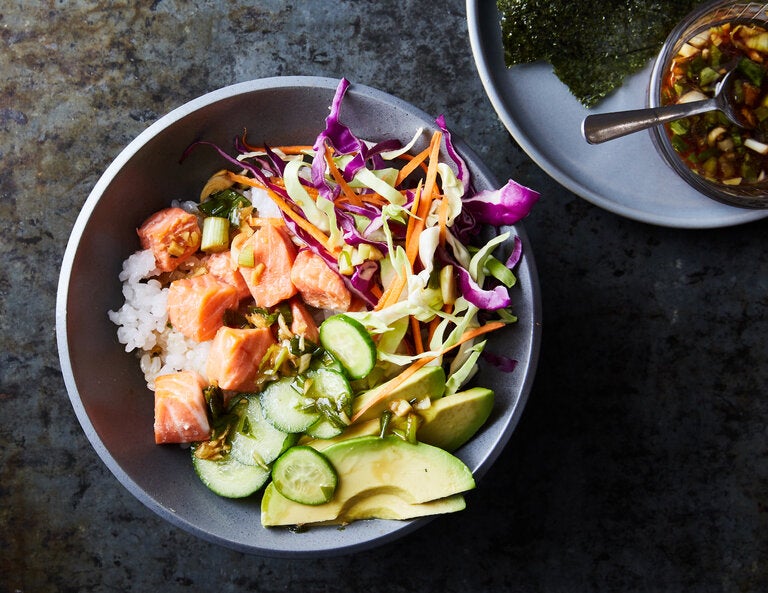
bowls
Ingredients
4 tablespoons + 3 tablespoons rice vinegar
3 tablespoons sugar
1 teaspoon salt
340ml sushi rice (measured in a jug), rinsed in a sieve under running water until the water
runs clear
500g (or up to 680g if you’re really hungry) skinless mackerel fillets, cut into 2cm-wide
strips
1 teaspoon toasted sesame oil, divided into two portions of ½ teaspoon each.
800g green and/or red cabbage and carrots (combined weight)
6 tablespoons soya sauce
3 tablespoons neutral vegetable oil
3 tablespoons coarsely chopped spring onions (white and light green parts)
3 tablespoons minced fresh ginger
Big handful of fresh coriander, coarsely chopped
1 cucumber, thinly sliced
1 avocado, halved, pitted and thinly sliced
Several toasted nori sheets, torn into bits, for garnish
Method
In a large saucepan, combine 4 tablespoons rice vinegar, sugar and salt; stir to dissolve the
sugar. Add the rice and 400ml water, and mix well. Bring to a boil over high heat, then cover and reduce heat to low. Cook until rice is tender and most of the liquid is absorbed, about 20 minutes.
While the rice is cooking, toss the fish with ¼ teaspoon sesame oil in a small bowl, and set
aside. Shred the cabbage. Peel the carrot and grate coarsely.
Combine the soya sauce, remaining 3 tablespoons of vinegar, oil, spring onions, ginger and
the remaining ¼ teaspoon of sesame oil in a large bowl. Mix well and then add the shredded
cabbage. Using your hands, scrunch up the cabbage as hard as you can, so that it softens a bit
and begins to absorb the dressing. Toss in the carrots and coriander and set aside.
Once rice is tender (after about 20 minutes), arrange the mackerel on top of the rice in an
even layer. Cover and cook over low heat until fish is just barely cooked, about 5 minutes
longer.
Now serve: scoop the rice and fish into individual bowls. Decorate each with some of the
cabbage-carrot-coriander salad, some sliced cucumber, and some sliced avocado. Top with
the toasted nori and enjoy.
Recipe adapted from Kay Chun, New York Times Cooking
A Recipe from Rebecca: Miso-Butter Pasta With Squash
This recipe by Yasmin Fahr in the New York Times yields impressive flavour and a surprisingly creamy texture. As Fahr observes, it ‘hits all the right notes: sweet, salty and savory’. The lime juice and zest contrasts with the richness of the buttery squash or pumpkin, and the combination of miso, butter an cheese is magical. In fact, if you like this, and you will, then definitely try the NYT’s ‘five ingredient creamy pasta’ (https://cooking.nytimes.com/recipes/1020979-five-ingredient-creamy-miso-pasta).
Serve with a green salad. This is a great use of that Hallowe’en pumpkin, if that happens to be still hanging around.
Miso-Butter Pasta With Squash
Serves 4
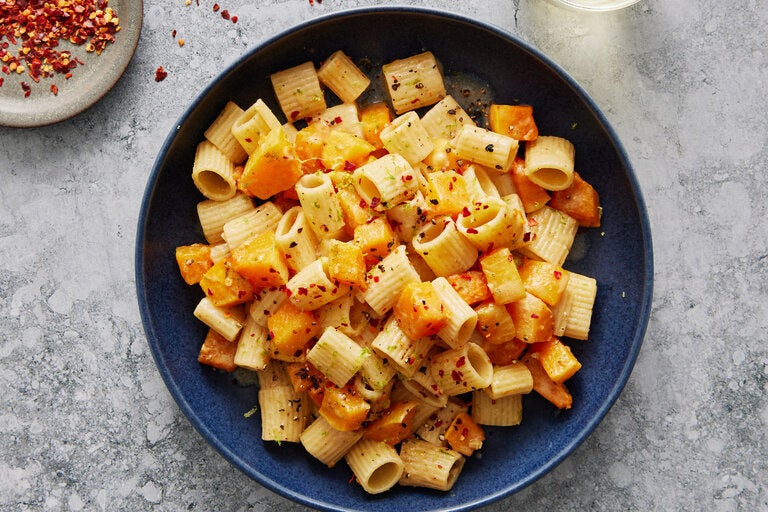
Ingredients
2 tablespoons unsalted butter, at room temperature
2 teaspoons white miso
3 to 5 large garlic cloves, crushed to a paste in a mortar and pestle with a little salt
1 tablespoon olive oil
Several grinds of black pepper
1 kilo squash or pumpkin, peeled and cut into 1cm cubes
500g rigatoni or other short pasta
50g grated Parmesan, plus more for serving
1-2 limes, zested and juiced, to yield 2 teaspoons zest and 2 tablespoons juice
Pinch of red-pepper flakes (optional)
Method
Heat the oven to 230C. Combine the softened butter, miso, crushed garlic and olive oil in a small bowl. Grind in some pepper. Dump the cubed squash or pumpkin onto a sheet pan and, using your hands, coat it in the miso-garlic butter. Spread it out evenly on the sheet pan, so the pieces are not all piled up on top of each other. Roast in the oven for 20-30 minutes, or until easily pierced by a fork.
When the squash or pumpkin has been roasting for about 10 minutes, bring a large pot of salted water to a boil. Add the pasta, adjusting the heat to maintain a gentle boil, and cook until just shy of al dente. Use a mug to remove about 250ml of the cooking water, and set aside. Now drain the rest of the water off the pasta.
When the squash or pumpkin is done, return the pasta to the pot over low heat. Scrape in the squash or pumpkin and any remaining miso butter, then add the Parmesan and about 100ml of the pasta water, stirring well until the noodles have a light sheen to them. If it appears dry, add more pasta water a little at a time until you reach your desired consistency. Stir in the lime zest and juice, season to taste with salt, pepper and the red-pepper flakes, if using. Serve with extra cheese.
Recipe by adapted from New York Times Cooking
Recipe of the Week: Beetroot Brownies
A great way of using beetroot for a little sweet treat!
Beetroot brownies
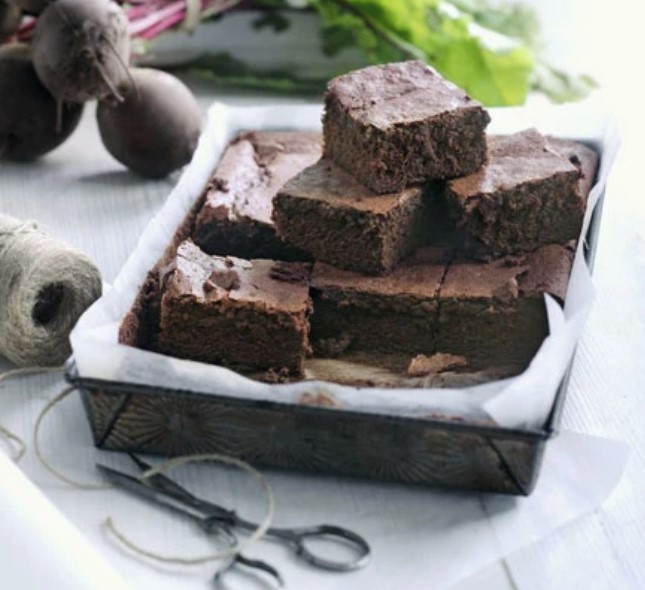
Ingredients
500g whole raw beetroot (3-4 medium beets)
100g unsalted butter, plus extra for the tin
200g bar plain chocolate (70% cocoa)
1 tsp vanilla extract
250g golden caster sugar
3 eggs
100g plain flour
25g cocoa powder
Method
Wear a pair of rubber gloves to stop your hands from staining, then top, tail and peel the beetroot – you’ll need about 400g flesh. Roughly chop and put into a large bowl. Add a splash of water, cover with cling film, then microwave on High for 12 mins or until tender.
Heat oven to 180C/160C fan/gas 4. While the beetroot cooks, butter then line a 20 x 30cm traybake or small roasting tin. Roughly chop the chocolate and cut the butter into cubes. Tip the cooked beetroot into a sieve, drain off any excess liquid, then put into a food processor or blender with the chocolate, butter and vanilla. Whizz until the mix is as smooth as you can get it. The chocolate and butter will melt as you do this.
Put the sugar and eggs into a large bowl, then beat using an electric hand whisk until thick, pale and foamy, about 2 mins. Spoon the beetroot mix into the bowl (it won’t look too pretty at this stage, but bear with me), then use a large metal spoon to fold it into the whisked eggs. Try to conserve as much air in the mixture as you can. Sift in the flour and cocoa powder, then gently fold these in to make a smooth batter.
Pour into the prepared tin and bake for 25 mins or until risen all over, with just the merest quiver under the centre of the crust when you shake the pan. Cool completely in the tin, then cut into squares.
From https://www.bbcgoodfood.com/recipes/beetroot-brownies
A Recipe from Rebecca: Quinces
Perhaps you have been tempted by the mysterious yellow quinces in the ‘extras’ section. Here is something delicious you can do with them. Claudia Roden reports that honeyed chicken with quince is a classic of Moroccan cookery, and it is very good. The chicken is simmered with honey and North African spices, and adorned with slices of quince. Serve it with rice or couscous.
But if it all seems a bit much you can enjoy the quinces simply for their delicate fragrance, which will perfume your kitchen if you leave them in a bowl on your worktop. Quinces have long been famous for their aroma, as this poem ascribed to the tenth-century Andalusian diplomat Jafar ibn Uthman al-Mushafi illustrates.
It is yellow in colour, as if it wore a daffodil
tunic, and it smells like musk, a penetrating smell.
It has the perfume of a loved woman and the same
hardness of heart, but it has the colour of the
impassioned and scrawny lover.
Its pallor is borrowed from my pallor; its smell
is my sweetheart’s breath.
When it stood fragrant on the bough and the leaves
had woven for it a covering of brocade,
I gently put up my hand to pluck it and to set it
like a censer in the middle of my room.
It has a cloak of ash-coloured down hovering over
its smooth golden body,
and when it lay naked in my hand, with nothing more than
its daffodil-coloured shift,
it made me think of her I cannot mention, and I feared
the ardour of my breath would shrivel it in my fingers.
Isn’t that Aphrodite’s apple?
Honeyed Chicken with Quince
Serves 4
Ingredients
2 quince
500g shallots or very small onions
1 medium onion, chopped
4 tablespoons sunflower oil + an additional tablespoon of oil for frying the quinces
2 teaspoons ras el hanout, or 1 teaspoon ground ginger + 1 teaspoon ground cinnamon + a pinch of saffron
1.6kg chicken, cut into pieces, or the equivalent in chicken pieces
250ml water
1 teaspoon salt and black pepper to taste
1 tablespoon honey
Method
Bring to the boil a pot large enough to hold the quince. Simmer the quince in the pot until they are tender. This will take between 20 and 60 minutes, depending on the quince, so you will need to check regularly. You don’t want them to fall apart completely. Once the quince are tender, remove them from the pot and leave to cool.
Meanwhile you can prepare the shallots (or onions): bring another pot of water to the boil and add the unpeeled shallots or onions. Boil for 5 minutes, and then drain. Once they are cool enough to handle, peel them and remove the rooty end. Set aside.
Over medium heat, warm 4 tablespoons of oil in a pan large enough to hold the chicken. Add some of the chicken and brown on all sides. Don’t crowd the pan too much, or else the chicken will steam rather than brown. As it browns remove it and continue with the remainder of the chicken.
Remove all the now-browned chicken from the pan and add the chopped onion. Lower the heat and sauté for about 10 minutes, until it has softened. Add the spice and stir for a minute or two, until it smells fragrant.
Return the chicken to the pan and add the water, salt and several grinds of black pepper. Cover, and cook over low heat for 15 minutes. Remove the chicken breasts, which should now be cooked, and set them aside.
Add the peeled shallots (or onions) to the pot and continue to cook for about 25 minutes more, or until the remaining pieces of chicken are tender. Keep an eye on this while it is cooking and add more water if it seems to be drying out, which I think is unlikely.
While the chicken is cooking finish preparing the quince: cut the cooked quinces into quarters and remove the core, but leave the peel on—this will help hold the slices together. Cut each quarter in half the long way to make 8 thick slices from each quince. Heat the additional tablespoon of oil in a frying pan, and put in the cooked quinces, with a cut side down. Fry until they are brown and caramelised, and then turn them over to brown the other cut side. Lift them out of the pan and drain on a bit of kitchen paper. Set aside.
Once all the chicken has cooked remove it from the pan and add the honey. Increase the heat to medium-high and cook uncovered, stirring, until most of the liquid has evaporated and the onions are beginning to turn a beautiful caramel brown.
Return the chicken to the pan and add the quinces. Heat through and then see if it needs more pepper. You want a nice balance between sweetness and peppery sharpness.
Serve with with rice or couscous.
Recipe adapted from Claudia Roden, Arabesque: A Taste of Morocco, Turkey & Lebanon (2005).
A Recipe from Rebecca: Grilled Mackerel with Green Olive, Celery and Raisin Salsa
This salty, sweet and crunchy salsa pairs perfectly with the rich, oily mackerel. The Ottolenghi team urge you to use ‘good quality’ olives and ‘plump’ raisins. This dish works well alongside another Ottolenghi dish: quinoa and red Camargue rice salad with orange and pistachios:
Grilled Mackerel with Green Olive, Celery and Raisin Salsa
Serves 4
Ingredients
For the Salsa
125g celery stalks, thinly sliced
60g green olives, pitted and thinly sliced
3 tablespoons capers, rinsed
70g raisins
1½ teaspoons sherry vinegar
60ml olive oil
3 tablespoons runny honey
15g parsley, roughly chopped
Salt and pepper, to taste (if necessary)
For the Fish
2 tablespoons olive oil
4 mackerel fillets
Salt and pepper
Method
For the Salsa: Stir together the salsa ingredients aside from the salt and pepper, and leave to sit for at least 15 minutes. Longer is fine. Taste the result: it should be sweet, sour and salty. Add salt or pepper if you think it necessary.
For the Fish: Heat a frying pan over medium-high heat and add the olive oil. When it is hot add the mackerel fillets, skin side down. Leave them alone for 2 minutes: resist the urge to move them about in the pan. By this point the flesh on the side facing up should begin to cook. Carefully flip the fish over and cook for another 1 to 2 minutes more, or until it is just cooked. Remove the pan from the heat.
To serve, place the fish on a serving platter and top with spoonfuls of salsa.
Recipe adapted from Yotam Ottolenghi and Sami Tamimi, Ottolenghi The Cookbook (2008).
A Recipe from Rebecca: Beet Sorbet
My sister Susan, who recommended this recipe, says ‘This sorbet is a surprisingly tasty method of using up excess beetroot from one’s farm share. You might not think that beets would work as a dessert but if you try this recipe you will be pleasantly surprised’. You will need an ice cream maker for this.
Beet Sorbet
Serves 8-10
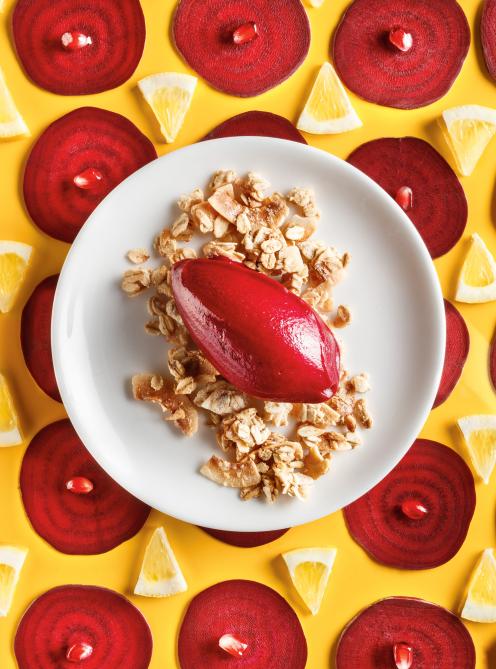
Ingredients
250ml pomegranate juice (use 100% pomegranate juice, not pomegranate juice drink)
600g beetroot, peeled and cut into cubes
100g sugar
1 tablespoon lemon juice
Method
In a saucepan, bring the pomegranate juice and beet cubes to a boil. Cover and simmer for 20 minutes or until the beets are very tender.
In a blender, purée the beets and their juice, along with the sugar and lemon juice. Transfer to a bowl. Cover and refrigerate for 4 hours or until completely chilled.
Pour the chilled purée into an ice cream maker and churn for 20 minutes, until thickened (or follow the manufacturer’s instructions).
Transfer to an airtight container and freeze for 4 hours or until firm. If desired, let the sorbet soften for a few minutes at room temperature before serving.
Recipe adapted from Ricardo Cuisine, https://www.ricardocuisine.com/en/recipes/8007-beet-sorbet
A Recipe from Rebecca: Thomasina Miers’ Quail with Turkish Runner Beans
Quail cook in no time; you can order them from Aubrey Allen, in Leamington. Here the little birds are served on a bed of runner beans tossed with a spicy, roasted tomato and red pepper sauce, and topped with Greek yoghurt and a sprinkling of dill. Serve with good bread for a really special dinner.
Thomasina points out that the sauce is also delicious on pasta. Cook some spaghetti, and throw in some spinach a few minutes before it’s done. Drain (keeping back a teacup of the cooking water), return to the pan, and stir in the sauce, along with the teacup of water. Mix together over low heat for a minute or two, to allow the flavours to meld, and serve with some grated cheese.
Quail with runner beans and roast red pepper and tomato sauce
Serves four.
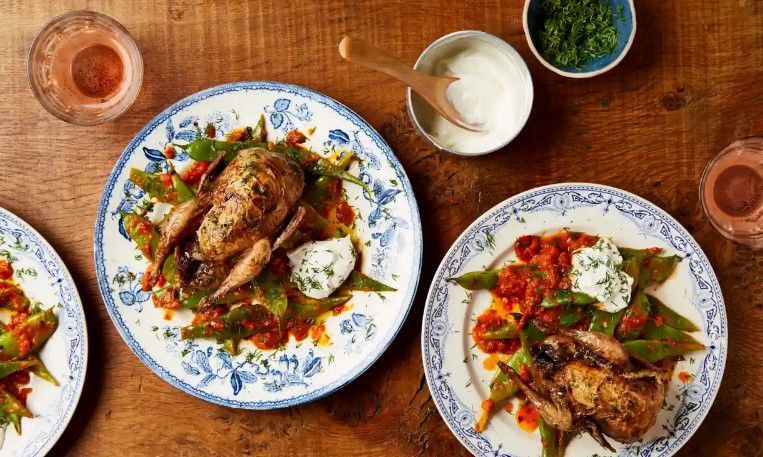
Ingredients
For the Turkish beans
2 red peppers
2 garlic cloves, skin left on
4 medium tomatoes, cut in half
salt and pepper
1 teaspoon thyme leaves, divided into two portions
2 tablespoons olive oil, plus extra to drizzle over the tomatoes and peppers before they roast.
700g runner beans, tough outer edges shaved off, and cut into 4cm lengths
For the quail
1 garlic clove, peeled
¼ teaspoon salt
½ teaspoon ground cinnamon
½ tsp ground allspice
2 tablespoons olive oil
4 quails
2 teaspoons harissa
To serve
Greek yoghurt
Fresh dill, finely chopped
Method
Prepare the Turkish beans: Heat the oven to 220C. Put the peppers and the 2 cloves of unpeeled garlic on one side of an oven tray and the tomatoes (skin side up) on the other. Season everything with salt, pepper, half the thyme, and a drizzle of oil. Roast for 20 minutes, then check on the garlic: if it’s soft, remove from the tray and set aside. If not, give it three or four minutes more. Turn over the peppers and return the tray to the oven for five to 10 minutes, until the peppers and tomatoes are slightly blackened. Set aside and leave for 10 minutes.
Once they are cool peel the skin off the peppers, using your fingers or a small knife. Discard the skin, and then cut in half. Remove and discard the seeds and stem. Slip the roast garlic out of its papery skin. Put the garlic, peppers and tomatoes in a food processor, add the remaining thyme, harissa and the two tablespoons of olive oil, and blitz to a coarse sauce. Season to taste and transfer to a medium saucepan.
Bring a pan of salted water to a boil and cook the beans for five minutes, or until al dente. Drain, and then tip the beans into the sauce. Mix together and cook on a low heat for five minutes, so the sauce thickens and reduces, and thoroughly coat the beans. Set aside; when you are ready to serve reheat it over a gentle flame until it is warmed through.
Prepare the Quail: Preheat the oven to 220C. Crush the garlic to a rough paste in a pestle with the salt, then add the cinnamon, allspice and two tablespoons of oil. Put the quail on an oven tray and rub all over with the spiced oil. Roast for 25-30 minutes, until the skin is crisp and the legs come away easily from the sides. Leave to rest for 10 minutes.
To serve, spoon some of the beans on to the centre of each plate and top with a quail. Finish with a dollop of yoghurt and a scattering of chopped dill.
Recipe adapted from The Guardian, 2017
A Recipe from Rebecca: Grilled Cucumbers with Tomato-Cardamom Dressing and Mozzarella
Here is another thing to do with cucumbers when you tire of slicing them into salads. Yotam Ottolenghi remarks that ‘grilling cucumbers gives them a nice charred flavor while retaining their bite. . . Torn mozzarella adds richness to the cucumbers doused with a garlicky, spiced tomato dressing’. You could also grill the cucumbers on an outdoor grill, if you run to such things. I used a mixture of cucumbers and slim courgettes, which worked very well. Serve with some good bread to soak up the excellent tomato sauce.
Grilled Cucumbers with Tomato-Cardamom Dressing and Mozzarella
Serves 4 as part of a larger meal or 2 as a main
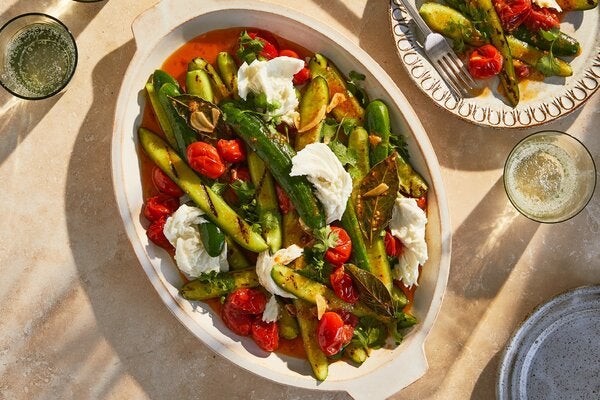
Ingredients
For the Tomato Dressing
500g tomatoes, chopped into large chunks
7 tablespoons olive oil
6 garlic cloves, peeled and thinly sliced
2 teaspoons white miso
4 fresh bay leaves
18 cardamom pods, roughly crushed in a mortar and pestle
½ teaspoon sweet smoked paprika
½ teaspoon salt
2 tablespoons lime juice
a few grinds of black pepper
For the Cucumbers
800g cucumbers (you could instead use slim courgettes, or a mixture of both)
1 tablespoon olive oil
½ teaspoon salt
a few grinds of black pepper
1 ball buffalo mozzarella (about 125g), roughly torn
about 8g coriander leaves and soft stems, roughly chopped
Method
Start with the dressing: put the tomatoes, oil, garlic, miso, bay leaves, crushed cardamom pods and seeds, paprika, and salt in a large (lidded) sauté pan. Place over medium-high heat, give everything a good stir and heat, uncovered, until it starts to bubble gently.
Once the dressing is bubbling, turn the heat down to medium-low, cover with the lid and cook gently for 15 minutes, stirring once, until the tomatoes have burst and start to release their juices. Turn down the heat if necessary; you want the garlic to soften without taking on colour, and you don’t want the tomatoes to disintegrate completely. Remove from the heat, stir in the lime juice, season to taste with pepper, and set aside.
Now prepare the cucumbers (or courgettes): halve the cucumbers (or courgettes) lengthwise and then halve each of these pieces lengthwise, to make four long cucumber wedges. You need these to fit into your griddle pan, so cut them in width-wise if necessary, to make shorter lengths. Put the vegetables into a bowl and toss with the oil, salt, and a good grind of pepper.
Heat a grill pan over high, and open a window. This might get a bit smoky.
When the grill pan is very hot, grill the cucumbers (or courgettes) in batches, cut sides down, for 2 to 3 minutes, then flip them over and grill for 1 to 2 minutes more. You want nice grill marks and for the cucumbers to soften but still retain a bite. Courgettes will take a little longer. As they become ready, transfer to the tomato pan, stirring to coat in the dressing.
Once all the veg have been grilled, stir the coriander into the pan and transfer the mixture to a large serving platter. Sprinkle on the torn mozzarella, along with a good pinch of salt, and serve hot or at room temperature.
Recipe adapted from Yotam Ottolenghi in New York Times Cooking
A Recipe from Rebecca: Vicki Behm’s Lentil Salad
Vicki Behm is an outstanding cook, and this is a very good salad. As the name implies, it keeps well, in addition to being tasty. Consider packing some in a box to take to work for lunch. I think you could use other types of green olive if you don’t have any Castelvetrano olives to hand.
Make-Ahead Lentil Salad, 4 servings
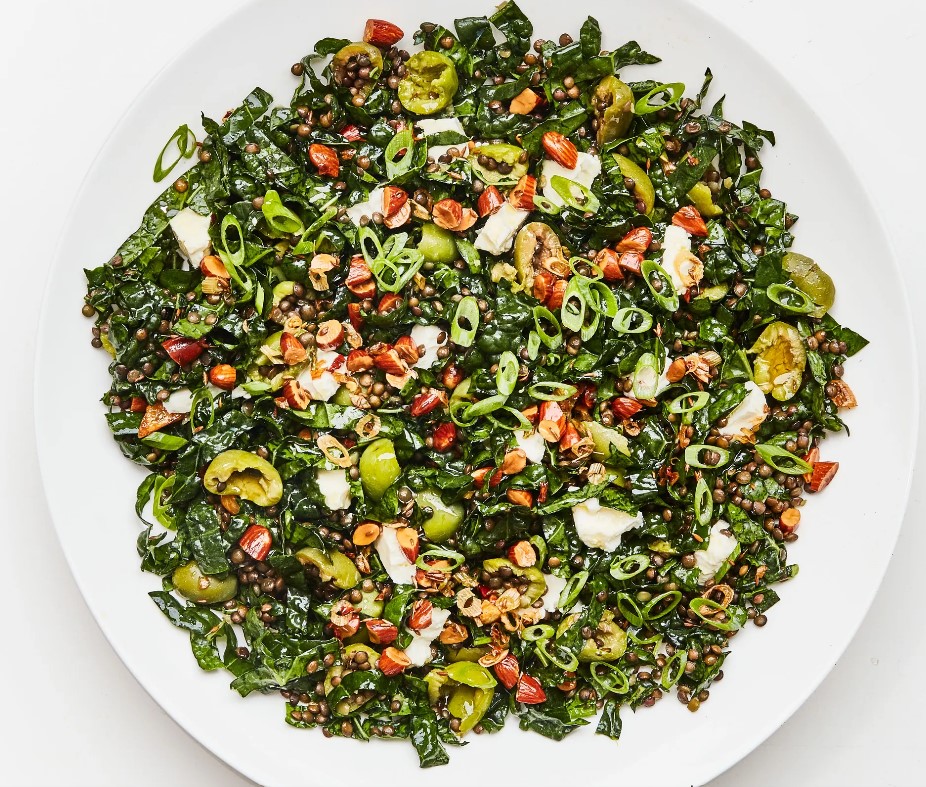
Ingredients
1 large bunch kale
12 ounces (measured in a measuring jug) of puy lentils
3 spring onions
4 garlic cloves
1 lemon
4 tablespoons olive oil
4 tablespoons raw almonds, coarsely chopped
1 tablespoon cumin seeds
½ teaspoon crushed red pepper flakes
140g feta
150g Castelvetrano olives, crushed with the side of a knife, and pits removed
salt
Method
Strip the kale leaves off the stems; discard stems or save for later. Stack the leaves on top of each other, then roll into fat cigars. Slice crosswise into ½ cm strips to form long, thin ribbons. Unfurl the ribbons. If any are really, long cut these into shorter ribbons that will be easier to get into your mouth. Transfer the ribbons to a large bowl, season with salt, and then use your hands to massage the kale: scrunch the kale up in your hands for 1 to 2 minutes, until it is silkier, softer, and darker in colour. This makes it more tender and nicer to eat raw. Place the kale ribbons in a large serving bowl.
Bring a large pot of heavily salted water to a boil over high heat. Add the lentils, reduce heat to medium, and simmer, uncovered, until the lentils are tender but still al dente, about 20–25 minutes. Try not to overcook them or they’ll be mushy.
While the lentils are cooking, prepare the spiced oil. Trim the spring onions and separate white and green parts. Thinly slice the white parts and transfer to a small skillet. (Keep the green parts—they will be used later in the recipe.) Peel the garlic and crush it with a knife. Add those to same skillet. Using a vegetable peeler or paring knife, remove three 8cm strips of lemon peel (avoiding white pith); reserve the rest of the lemon for your salad dressing. Add peels to skillet as well. Now pour the olive oil into skillet and stir so that all of the elements are coated in oil.
Heat the skillet over medium heat. Cook, stirring occasionally, until the garlic starts to brown and the lemon peel starts to curl, about 3 minutes. Add the almonds and cook, stirring frequently, until almonds are browned, about 3 more minutes. Remove from heat and stir in the cumin seeds and red pepper flakes—the residual heat from the oil will warm those spices and bring out their flavours.
Strain the oil mixture through a fine-mesh sieve into a small bowl, shaking to help the oil drain. Don’t throw away the stuff in the sieve! The oil will form the base of your salad dressing and the stuff in the sieve will add crunch to the salad. Spread the contents of the sieve on a paper towel-lined plate, season with salt, and let cool. The nuts will get crunchier as they sit.
Crumble the feta into the bowl with the kale. Tear the olives into large pieces and add them to the bowl as well. Thinly slice the reserved spring onion greens and add most of them to the bowl, reserving just a few for a garnish. Juice the lemon and add it, along with ½ teaspoon salt, to the serving bowl.
Once the lentils are cooked, drain them well, shaking to get rid of excess moisture, and add to bowl; season with salt. Add the infused oil and half of almond-spice mix, and toss to combine. Garnish with the remaining nuts and spices, and spring onion greens, and serve.
Recipe adapted from Bon Apétit, 2020
A Recipe from Rebecca: Refrigerator Pickles
My grandmother used to make refrigerator pickles, which (as the name implies) need to be stored in the fridge. Here is an easy recipe for converting an abundance of courgettes into crisp, dilly pickles to have alongside your sandwich or in a burger.
Refrigerator Courgette Pickles
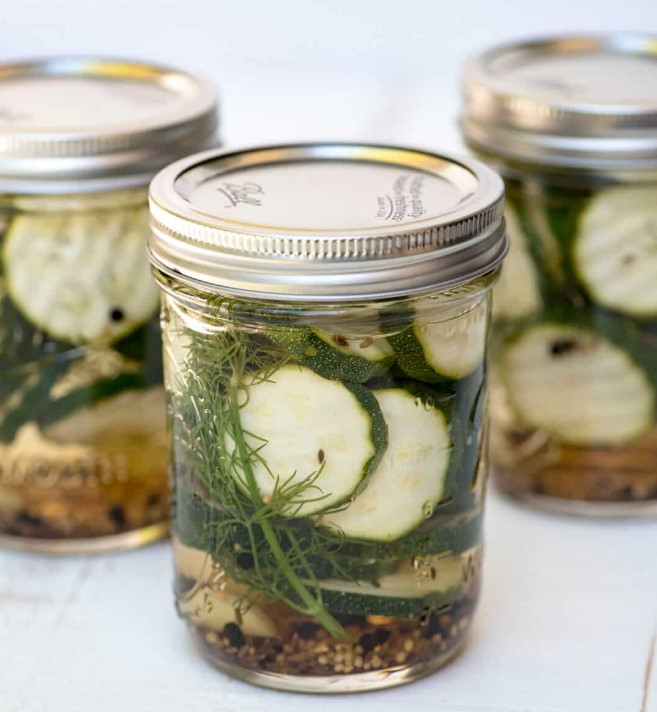
Ingredients
For the Pickles
3 garlic cloves, peeled and halved
1½ teaspoons black peppercorns
1½ teaspoons mustard seed
6 sprigs of fresh dill
700g courgettes
For the Brine
500ml water
250ml white vinegar
4 tablespoons sugar (I used muscovado)
2 tablespoons coarse sea salt
Method
Sterilise the jars in which you intend to store the pickles by pouring boiling water over them; you’ll need about 4 normal-sized jam jars or the equivalent. (See note below, as well.)
Divide the garlic, peppercorns, mustard seed and dill between them.
Wash, top and tail the courgettes. Slice into circles or spears, as you prefer, and pack neatly into the jars. Leave a bit of space at the top of each jar, so the courgettes can be covered completely in the brine.
Heat the brine ingredients over medium-high heat in a saucepan and boil until the sugar and salt dissolve.
Carefully pour the brine into your jars, put on the lids, and let cool to room temperature. (See note below, as well.)
Give the jars a good shake to distribute the spices and then store in the fridge for at least 24 hours before eating. They should last for some weeks.
NOTE: If the courgettes float to the surface you might want to weigh them down with something, to ensure they remain submerged in the brine, e.g. a smaller jam jar, ramekin dish etc. Make sure you sterilize these, too, with boiling water.
Recipe adapted from Valerie Brunmeier, Valerie’s Kitchen (2017)